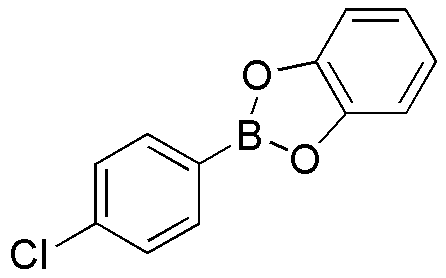4-Chlorophenylboronic acid, catechol cyclic ester is widely utilized in research focused on:
- Drug Development: This compound serves as a key building block in the synthesis of various pharmaceuticals, particularly in the development of anti-cancer agents that target specific cellular pathways.
- Organic Synthesis: It is employed in Suzuki coupling reactions, which are essential for forming carbon-carbon bonds in organic compounds, making it valuable in creating complex molecules for research and industrial applications.
- Bioconjugation: The compound is used in bioconjugation techniques, allowing researchers to attach biomolecules to surfaces or other molecules, enhancing the functionality of diagnostic tools and drug delivery systems.
- Sensor Technology: Its properties make it suitable for developing sensors that detect specific biomolecules, which is crucial in medical diagnostics and environmental monitoring.
- Material Science: This chemical is utilized in the production of advanced materials, including polymers and nanomaterials, which have applications in electronics and coatings due to their unique properties.
Informations générales
Propriétés
Sécurité et réglementation
Applications
4-Chlorophenylboronic acid, catechol cyclic ester is widely utilized in research focused on:
- Drug Development: This compound serves as a key building block in the synthesis of various pharmaceuticals, particularly in the development of anti-cancer agents that target specific cellular pathways.
- Organic Synthesis: It is employed in Suzuki coupling reactions, which are essential for forming carbon-carbon bonds in organic compounds, making it valuable in creating complex molecules for research and industrial applications.
- Bioconjugation: The compound is used in bioconjugation techniques, allowing researchers to attach biomolecules to surfaces or other molecules, enhancing the functionality of diagnostic tools and drug delivery systems.
- Sensor Technology: Its properties make it suitable for developing sensors that detect specific biomolecules, which is crucial in medical diagnostics and environmental monitoring.
- Material Science: This chemical is utilized in the production of advanced materials, including polymers and nanomaterials, which have applications in electronics and coatings due to their unique properties.
Documents
Fiches de données de sécurité (FDS)
La FDS fournit des informations de sécurité complètes sur la manipulation, le stockage et l’élimination du produit.
Spécifications du produit (PS)
Le PS fournit une description complète des propriétés du produit, notamment sa composition chimique, son état physique, sa pureté et les exigences de stockage. Il détaille également les plages de qualité acceptables et les applications prévues du produit.
Certificats d'analyse (COA)
Recherchez des certificats d'analyse (COA) en saisissant le numéro de lot du produit. Les numéros de lot et de lot se trouvent sur l'étiquette d'un produit, après les mots « Lot » ou « Lot de fabrication ».
Numéro de catalogue
Numéro de lot/série
Certificats d'origine (COO)
Ce certificat d'exploitation confirme le pays dans lequel le produit a été fabriqué, et détaille également les matériaux et composants utilisés et s'il est issu de sources naturelles, synthétiques ou autres sources spécifiques. Ce certificat peut être requis pour les douanes, le commerce et la conformité réglementaire.
Numéro de catalogue
Numéro de lot/série
Fiches de données de sécurité (FDS)
La FDS fournit des informations de sécurité complètes sur la manipulation, le stockage et l’élimination du produit.
DownloadSpécifications du produit (PS)
Le PS fournit une description complète des propriétés du produit, notamment sa composition chimique, son état physique, sa pureté et les exigences de stockage. Il détaille également les plages de qualité acceptables et les applications prévues du produit.
DownloadCertificats d'analyse (COA)
Recherchez des certificats d'analyse (COA) en saisissant le numéro de lot du produit. Les numéros de lot et de lot se trouvent sur l'étiquette d'un produit, après les mots « Lot » ou « Lot de fabrication ».
Numéro de catalogue
Numéro de lot/série
Certificats d'origine (COO)
Ce certificat d'exploitation confirme le pays dans lequel le produit a été fabriqué, et détaille également les matériaux et composants utilisés et s'il est issu de sources naturelles, synthétiques ou autres sources spécifiques. Ce certificat peut être requis pour les douanes, le commerce et la conformité réglementaire.


